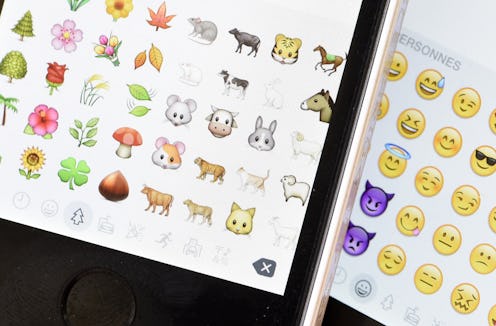The phenomenon that is the emoji keyboard has swept the world by storm, and as is the case with every other language or lexicon, that means a whole bunch of usage mistakes have come with it. You may have made emoji mistakes or fallen prey to confusion about what some emoji mean without even knowing it, because let's face it: Using those tiny little images on your phone both correctly and creatively isn't easy. But have no fear! I'm on the case. Today I'm here to help you refine the ways you use emoji, because everyone could use a grammer or vocab refresher every now and again — even when the language in question is pictorial.
Emoji are being integrated into our world in so many more ways now than just cell phone conversations and Facebook posts — and that's why it's more important than ever to understand the vernacular. We see them everywhere these days: In anti-drug campaigns, to help label allergens, as marketing strategies for companies such as Domino's and McDonald's, and more. With so many organizations out there using emojis, not to mention the hordes of smartphone users sending them every day, correct emoji usage is more critical than ever.
So, with all that in mind, here are five emoji mistakes you've likely been making and how to amend them. You want to be the best emoji communicator you can be, right? The future might depend on it!
1. You're not using them in the correct locations.
The amazing thing about emoji is how nuanced they are. The grinning cat means a different thing than smiling cat, for example, just like grinning and smiling mean different things in real life. However, emoji are meant to enhance a word or sentence by including a visual image along with it — and by and large, your meaning will come across the most clearly if you use emoji at the ends of sentences. For example, if I say, "I really miss you," and then add the pensive emoji, it acts like a piece of punctuation, clarifying for the reader that my missing them is more of a quiet sadness than a wailing sob. Putting the emoji before the sentence doesn't give it any context, which might lead to a translation error for the reader.
2. You're using them in serious situations.
It's OK if your friend is sad about a breakup and you want to respond with emoji hearts, but if someone tells you some serious news — things like a death, a family emergency, or a job ending — it's best to use fewer images and more words. Of course, this can very from person to person and situation to situation, so this rule has a little bit of flexibility; however, if you hear the news from or about a person you don't know very well, it's best to hold off on the emoji.
3. You're using them with the wrong people.
An article on Thought Catalog makes the excellent point that the use of emoji is a rite of passage for friendship. Why? Because it indicates a more casual mode of communication that only works with someone you know really well. Emoji may not go over quite as well with people you've only just become friendly with. Establish your friendship with words and actions first; emoji can come later.
4. You're being racist.
Racially diverse emoji exist for people of color to represent themselves and other people of color accurately. We don't all want to be portrayed as white, because we're not. Don't use these amazing, diverse images to make a racist, bigoted statement. And while we're on the subject, just don't be racist at all, thanks — in the digital world or in the physical one.
5. You're not being patient.
If you text your mom the toilet emoji, the no entry emoji, and the paper emoji, it might take her a second to understand that you're saying you're out of toilet paper. People often have wider interpretations of images than they do of words; as such, that particular emoji combination could be interpreted to mean everything from "I'm not going to do my homework on the toilet" to "Today's paper was total crap." So here's the important thing: If your reader doesn't get it, don't get mad at them. Clarify what you meant calmly, and ideally in a less ambiguous fashion. No one likes being yelled at when they don't know what they've done wrong — and in this case, they didn't even do anything wrong at all.
Those are just a handful of emoji etiquette rules that you can implement immediately. Good luck, modern people!
Images: Giphy (5)
